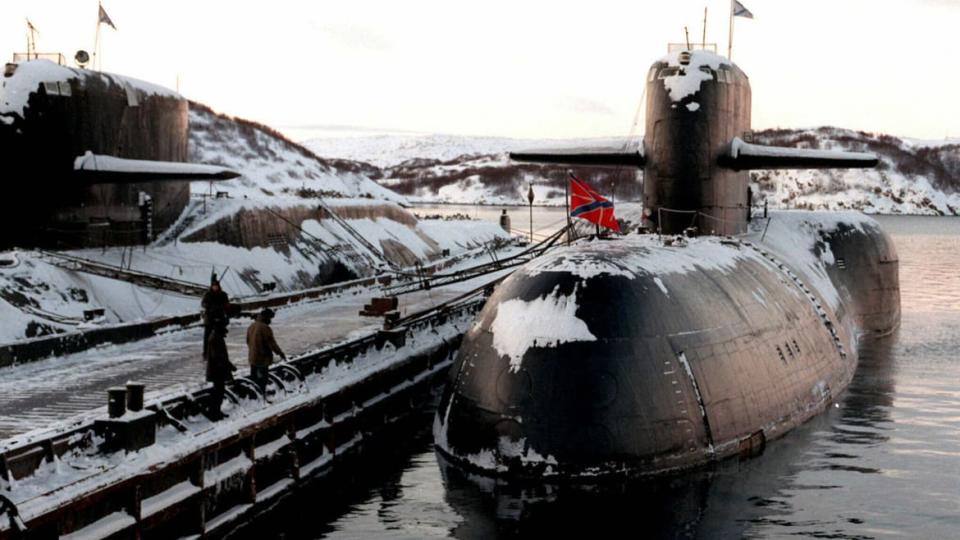What Was That Secret Russian Sub Doing Before It Caught Fire?
A fire broke out on a secretive Russian research submarine on Monday, killing 14 people and potentially slowing Russia’s efforts to develop new undersea weaponry.
Flames roared through the nuclear-powered Project 1083 Losharik submarine apparently while the vessel was near its home port of Severomorsk on Russia’s Arctic coast.
Among the crew who died in the accident are at least seven senior officers, two of whom had received the Hero of Russia award, the equivalent of the United States’ Medal of Honor.
Russian President Vladimir Putin described Losharik’s burning as a “big loss.” “This is not a regular vessel, you and I know this,” Putin told reporters.
Fishermen told SeverPost, a Murmansk news agency, they observed Losharik surfacing near Kildin Island in the Barents Sea around 9:30 p.m. local time on Monday. “It came out of the water, all of it,” one fisherman said.
“I’d never seen anything like that before,” the fisherman added. “There were people running, rushing on the deck.”
“Fire is the biggest nightmare for sailors serving on submarines,” Alexander Golts, an independent military analyst, told The Daily Beast. “Anything could cause a fire. A short circuit, somebody’s negligence—anything.”
The Losharik fire is Russia’s worst submarine disaster since 2008, when a fire-suppression system malfunctioned on the Russian navy attack submarine Nerpa, asphyxiating 20 people as the vessel underwent trials in the Sea of Japan.
Eight years earlier in 2000, the missile submarine Kursk suffered an explosion and sank in the Barents Sea, killing 118 people. The Kursk’s sinking and Putin’s slowness to respond were major scandals in Russia.
Nerpa and Kursk were fleet submarines with front-line military missions. Losharik by contrast is a deep-diving research vessel that belongs to the Kremlin’s Directorate of Deepwater Research.
Losharik’s roughly 200-foot-long hull consists of seven titanium compartments that protect the vessel from the high pressure of extreme depths. Norman Polmar, a submarine expert and naval adviser to top U.S. government officials, estimated Losharik can dive as deep as 20,000 feet. Fleet submarines, including the U.S. Navy’s Virginia-class vessels, typically dive no deeper than 600 or 700 feet.
Since launching in 2003, Losharik has undertaken some dangerous missions of national importance. In 2012 the submarine and an accompanying vessel drilled to a depth of almost two miles on the Arctic seabed in order to retrieve soil samples and identify the outer limits of Russia’s continental shelf.
Many of the vessel’s other duties are shrouded in mystery, but could involve trials of new sensors and weaponry. “It’s a very useful submarine,” Polmar said.
Research submarines such as Losharik arguably are more important than ever for Russia’s strategic plans. The Russian navy for years clung to its position as one of the world’s most powerful fleets largely by refurbishing Cold War-vintage surface warships.

But those ships and their support infrastructure are becoming harder to maintain. In October 2018 a fire broke out aboard PD-50, a 38-year-old floating drydock that at the time was cradling Admiral Kuznetsov, Russia’s sole aircraft carrier. PD-50 sank, damaging the carrier and killing two workers.
Russia’s Biggest Warship Steams to Syria
With no cheap or easy way to replace PD-50, the Kremlin is considering decommissioning the aging, unreliable Admiral Kuznetsov as part of a wider cull of Cold War-vintage vessels. To replace the old surface ships, Moscow has leaned on its historical strength as a builder of submarines.
Putin’s government in recent years has accelerated production of new subs while also developing high-tech new weapons to arm the vessels. Russia plans to maintain a fleet of around 50 modern submarines, roughly matching the U.S. Navy’s own undersea strength.
Russia’s submarine build-up includes the 574-foot-long Moscow, which is part-science vessel, part-spy ship, part-commando transport, and part-“mothership” for mini-subs and drones. Russia also is developing “Status-6,” an undersea drone that packs a radiological warhead that could contaminate vast stretches of enemy coast.
It’s unclear what Losharik was doing when the fire broke out. The Russian Defense Ministry did not respond to questions The Daily Beast sent via email. Michael Kofman, a Russia expert with the Wilson Center in Washington, D.C., said the fire was probably the result of “a demonstration gone awry, perhaps of some new technology.”
“You will note the casualty list includes seven captains first rank, on a submarine that would at most have one such officer serving,” Kofman noted.
“This was an extraordinary crew of top elite captains,” Golts told The Daily Beast. “Whoever put them together on that vessel gave these captains a complicated task, which required their expertise and experience in oceanographic research.”
Submariners are folk heroes in Russia. It’s not for nothing that the Russian public “is locked on the accident,” according to Pavel Podvig, an independent expert on the Russian military. Orthodox churches in the Russian port cities of Murmansk and Severomorsk on Wednesday held memorial services for the victims of the fire.
Perhaps fearing another scandal like the Kursk sinking, Putin swiftly responded to the Losharik incident. On Tuesday he canceled a planned event and summoned Defense Minister Sergei Shoigu to discuss the fire.
The damage and loss of life could have been much worse, Shoigu claimed. The defense minister told reporters the crew heroically saved the life of a civilian aboard Losharik and closed hatches to prevent the flames from spreading.
It’s unclear how much damage Losharik sustained and whether, or how quickly, the Kremlin could restore the vessel.
The fire at least has stymied Russia’s undersea ambitions, according to Pavel Luzin, a professor of political science at Perm University in Russia. “Definitely, Russia temporarily lost one of its most advanced naval capabilities that is aimed at maintaining Russia’s strategic operations.”
Get our top stories in your inbox every day. Sign up now!
Daily Beast Membership: Beast Inside goes deeper on the stories that matter to you. Learn more.

